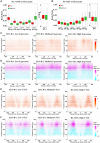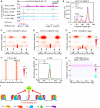Histone variant H2A.Z regulates nucleosome unwrapping and CTCF binding in mouse ES cells
- PMID: 32392318
- PMCID: PMC7293034
- DOI: 10.1093/nar/gkaa360
Histone variant H2A.Z regulates nucleosome unwrapping and CTCF binding in mouse ES cells
Abstract
Nucleosome is the basic structural unit of chromatin, and its dynamics plays critical roles in the regulation of genome functions. However, how the nucleosome structure is regulated by histone variants in vivo is still largely uncharacterized. Here, by employing Micrococcal nuclease (MNase) digestion of crosslinked chromatin followed by chromatin immunoprecipitation (ChIP) and paired-end sequencing (MNase-X-ChIP-seq), we mapped unwrapping states of nucleosomes containing histone variant H2A.Z in mouse embryonic stem (ES) cells. We found that H2A.Z nucleosomes are more enriched with unwrapping states compared with canonical nucleosomes. Interestingly, +1 H2A.Z nucleosomes with 30-80 bp DNA is correlated with less active genes compared with +1 H2A.Z nucleosomes with 120-140 bp DNA. We confirmed the unwrapping of H2A.Z nucleosomes under native condition by re-ChIP of H2A.Z and H2A after CTCF CUT&RUN in mouse ES cells. Importantly, we found that depletion of H2A.Z results in decreased unwrapping of H3.3 nucleosomes and increased CTCF binding. Taken together, through MNase-X-ChIP-seq, we showed that histone variant H2A.Z regulates nucleosome unwrapping in vivo and that its function in regulating transcription or CTCF binding is correlated with unwrapping states of H2A.Z nucleosomes.
© The Author(s) 2020. Published by Oxford University Press on behalf of Nucleic Acids Research.
Figures





Similar articles
-
Sequential Chromatin Immunoprecipitation to Identify Heterotypic Nucleosomes.Methods Mol Biol. 2021;2351:147-161. doi: 10.1007/978-1-0716-1597-3_8. Methods Mol Biol. 2021. PMID: 34382188
-
Genome-wide nucleosome specificity and function of chromatin remodellers in ES cells.Nature. 2016 Feb 4;530(7588):113-6. doi: 10.1038/nature16505. Epub 2016 Jan 27. Nature. 2016. PMID: 26814966 Free PMC article.
-
Structural basis of nucleosome dynamics modulation by histone variants H2A.B and H2A.Z.2.2.EMBO J. 2021 Jan 4;40(1):e105907. doi: 10.15252/embj.2020105907. Epub 2020 Oct 19. EMBO J. 2021. PMID: 33073403 Free PMC article.
-
Patterning chromatin: form and function for H2A.Z variant nucleosomes.Curr Opin Genet Dev. 2006 Apr;16(2):119-24. doi: 10.1016/j.gde.2006.02.005. Epub 2006 Feb 28. Curr Opin Genet Dev. 2006. PMID: 16503125 Review.
-
Reuniting the contrasting functions of H2A.Z.Biochem Cell Biol. 2006 Aug;84(4):528-35. doi: 10.1139/o06-077. Biochem Cell Biol. 2006. PMID: 16936825 Review.
Cited by
-
Whole-genome methods to define DNA and histone accessibility and long-range interactions in chromatin.Biochem Soc Trans. 2022 Feb 28;50(1):199-212. doi: 10.1042/BST20210959. Biochem Soc Trans. 2022. PMID: 35166326 Free PMC article. Review.
-
CTCF shapes chromatin structure and gene expression in health and disease.EMBO Rep. 2022 Sep 5;23(9):e55146. doi: 10.15252/embr.202255146. Epub 2022 Aug 22. EMBO Rep. 2022. PMID: 35993175 Free PMC article. Review.
-
Chromatin remodeler Dmp18 regulates apoptosis by controlling H2Av incorporation in Drosophila imaginal disc development.PLoS Genet. 2022 Sep 27;18(9):e1010395. doi: 10.1371/journal.pgen.1010395. eCollection 2022 Sep. PLoS Genet. 2022. PMID: 36166470 Free PMC article.
-
Coordinated DNA and histone dynamics drive accurate histone H2A.Z exchange.Sci Adv. 2022 Mar 11;8(10):eabj5509. doi: 10.1126/sciadv.abj5509. Epub 2022 Mar 9. Sci Adv. 2022. PMID: 35263135 Free PMC article.
-
CTCF binding landscape is shaped by the epigenetic state of the N-terminal nucleosome in relation to CTCF motif orientation.Nucleic Acids Res. 2025 Jun 20;53(12):gkaf587. doi: 10.1093/nar/gkaf587. Nucleic Acids Res. 2025. PMID: 40613712 Free PMC article.
References
-
- Luger K., Mader A.W., Richmond R.K., Sargent D.F., Richmond T.J.. Crystal structure of the nucleosome core particle at 2.8 Å resolution. Nature. 1997; 389:251–260. - PubMed
-
- Kato D., Osakabe A., Arimura Y., Mizukami Y., Horikoshi N., Saikusa K., Akashi S., Nishimura Y., Park S.-Y., Nogami J. et al. .. Crystal structure of the overlapping dinucleosome composed of hexasome and octasome. Science. 2017; 356:205. - PubMed
Publication types
MeSH terms
Substances
Grants and funding
LinkOut - more resources
Full Text Sources
Molecular Biology Databases

